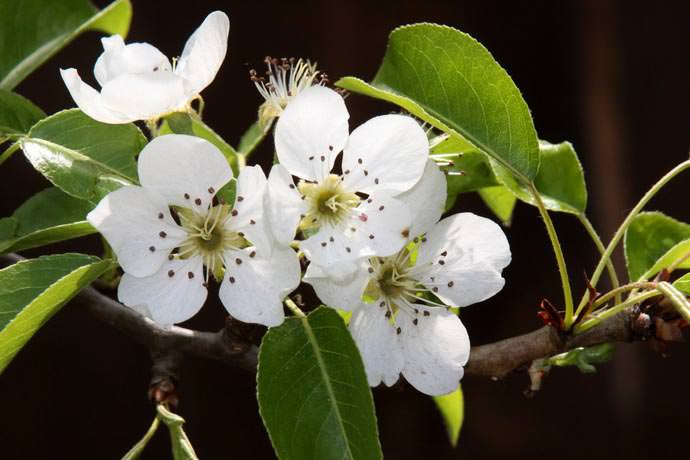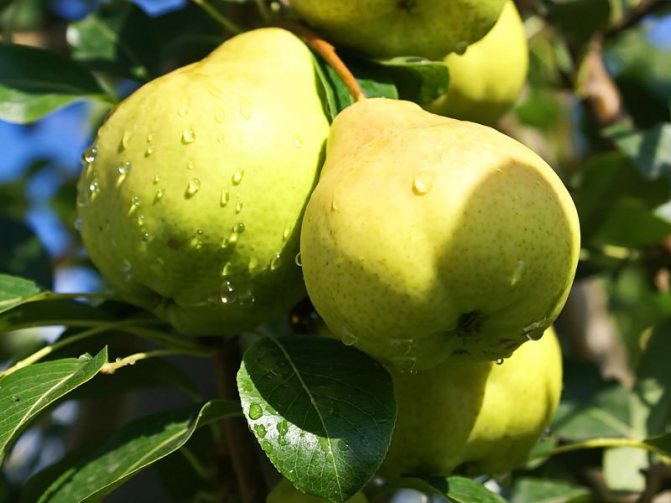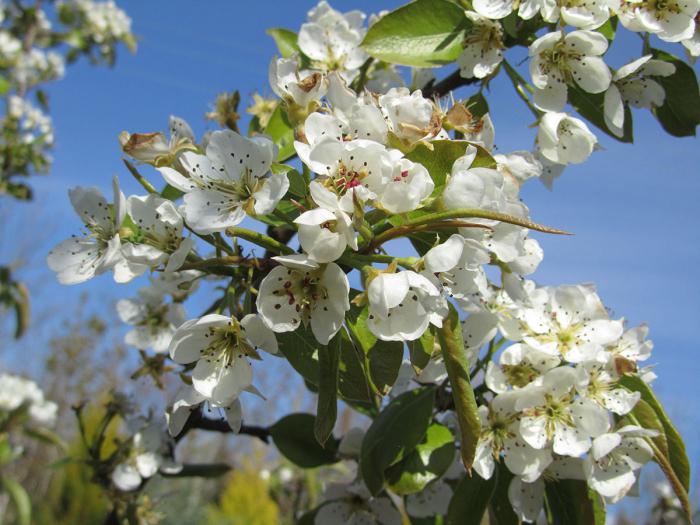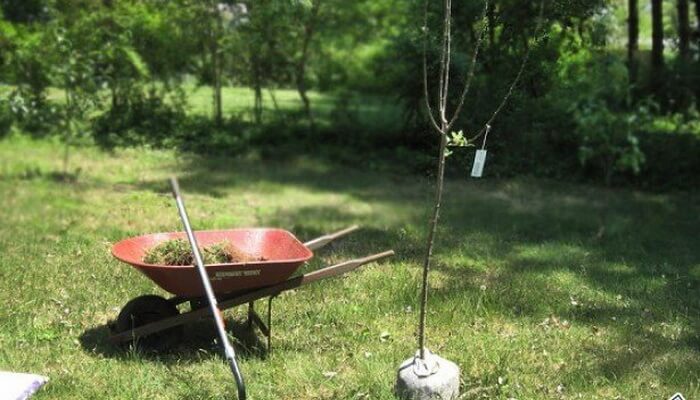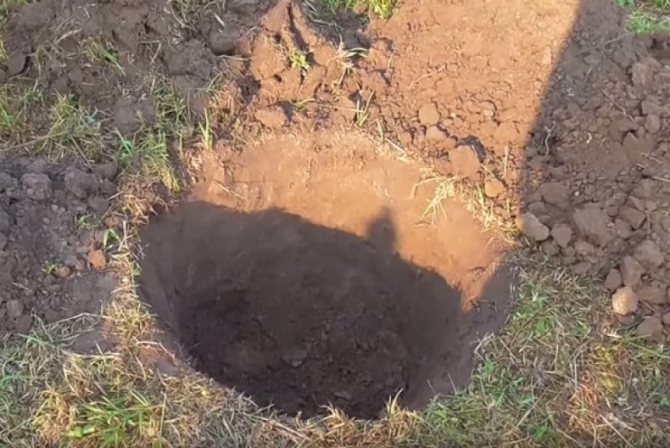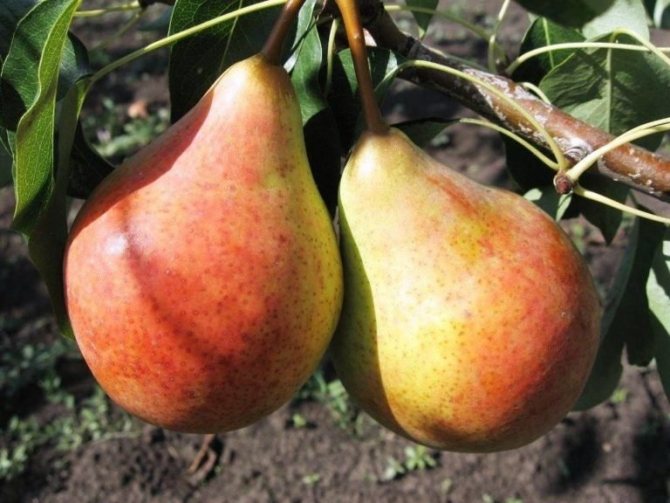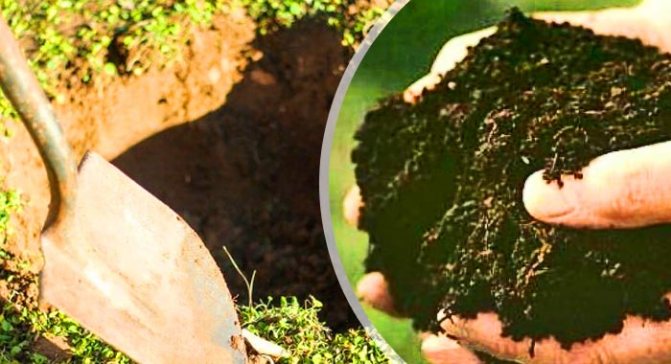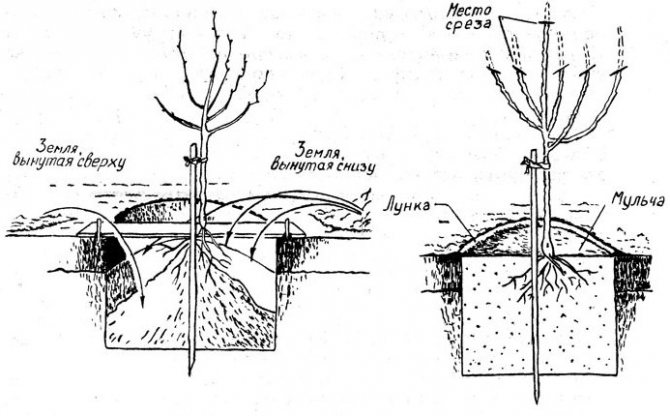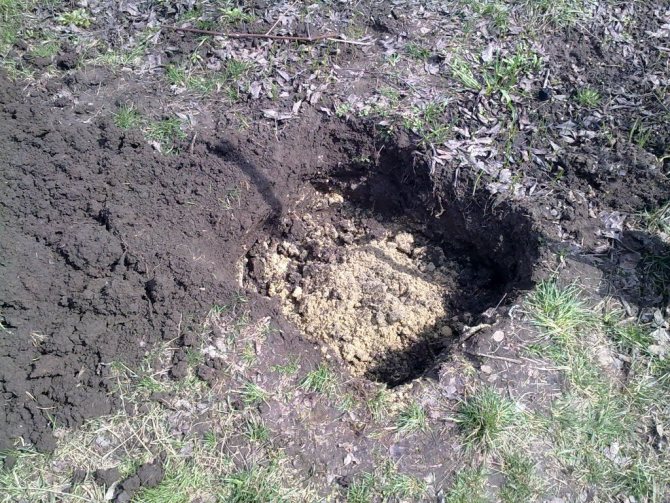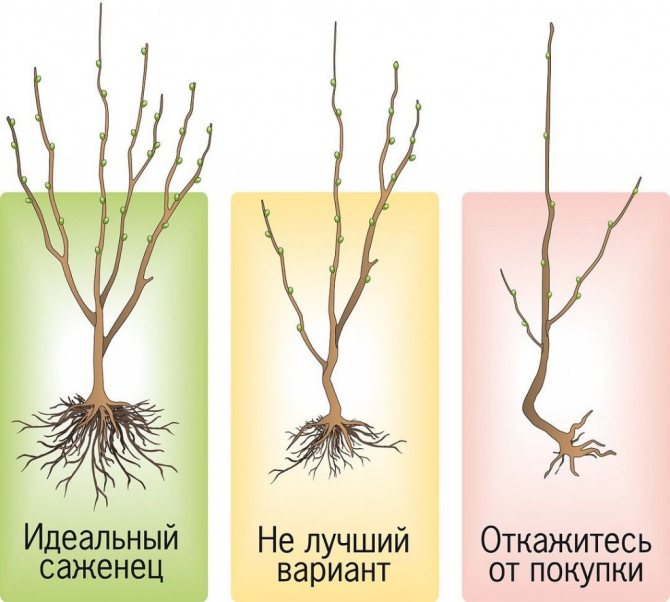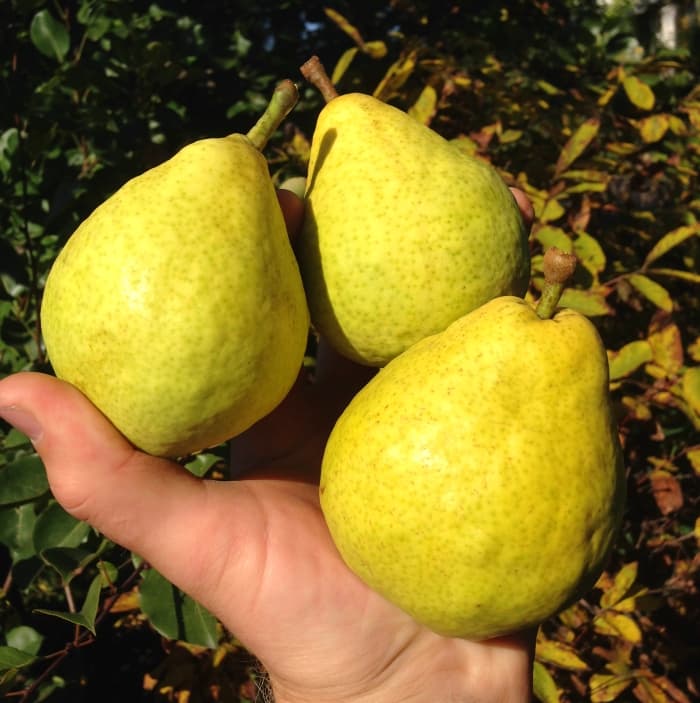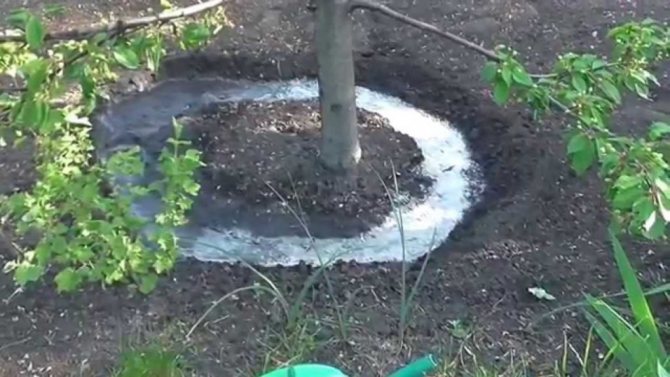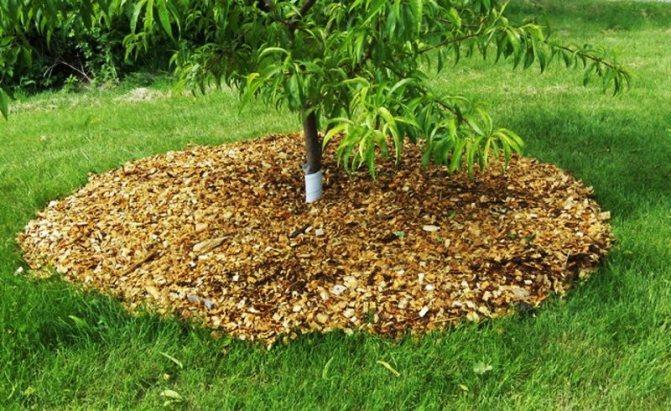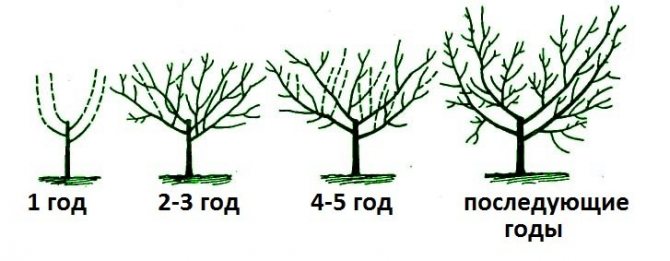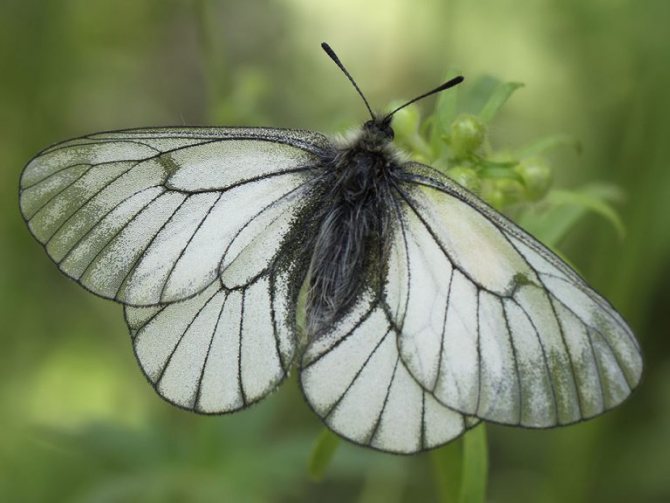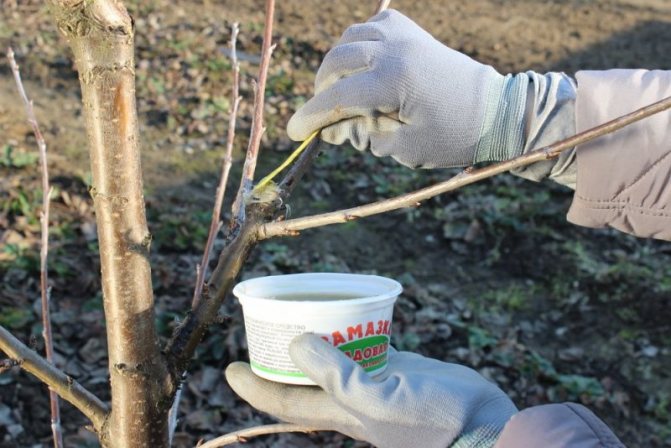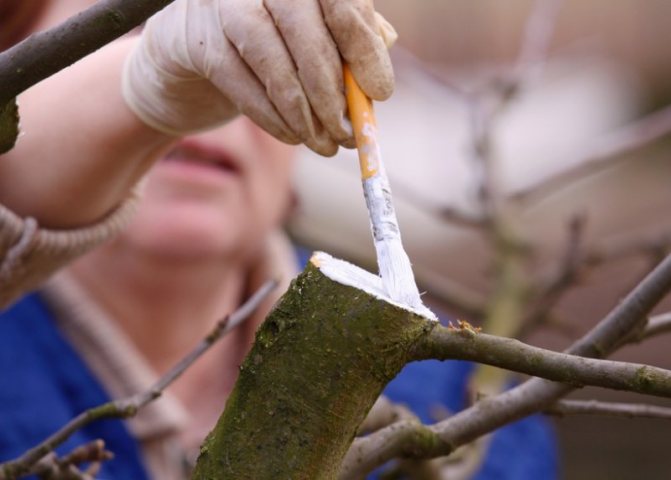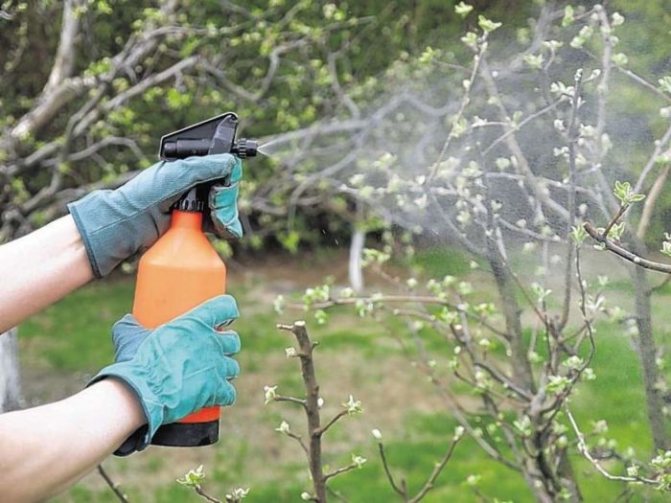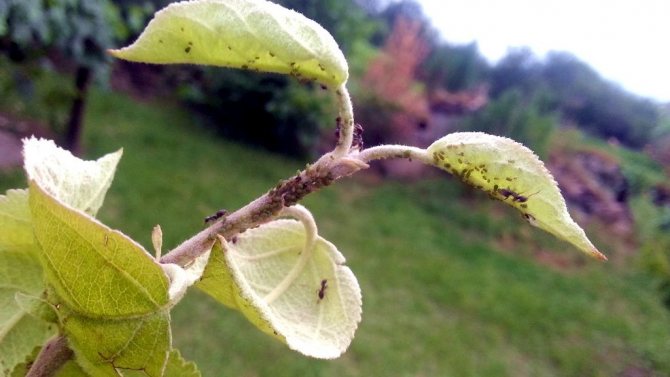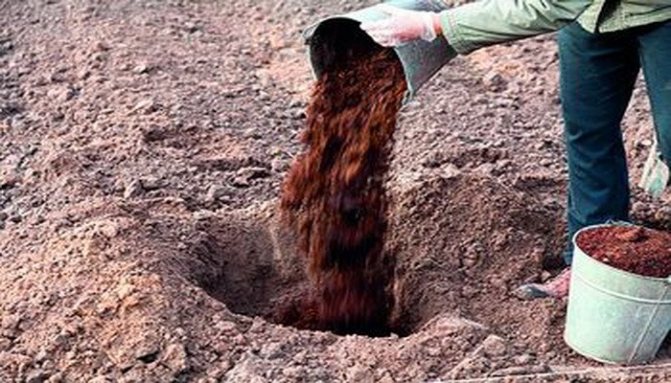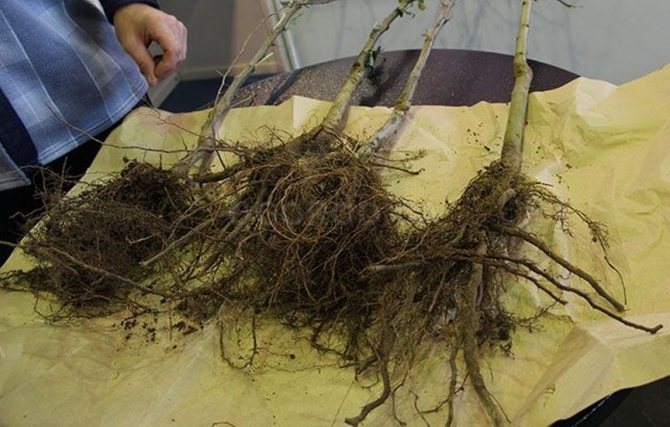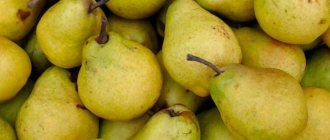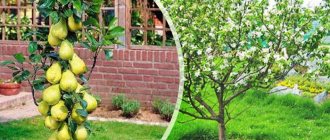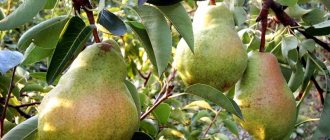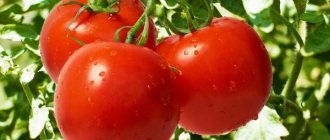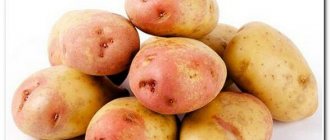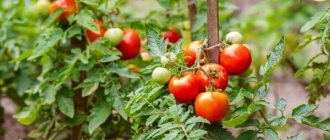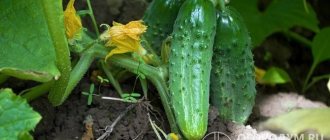Compared to the apple tree, the pear is less common in Russian orchards. This is despite the fact that there are quite a few varieties of this fruit tree. The fact is that the distribution area of pears is significantly influenced by its frost and drought-resistant qualities. But if you plant several varieties in the garden with different ripening periods, then you can provide yourself with delicious juicy fruits for the whole season. One of the most common in our gardens is the Muscovite pear, a description, photo, reviews and features of which we will present in this article. This variety, the fruits of which have a pleasant taste and aroma, is also ideal for use in winter preparations: for jam, compote, etc. That is why practically every second garden contains the Muscovite pear.
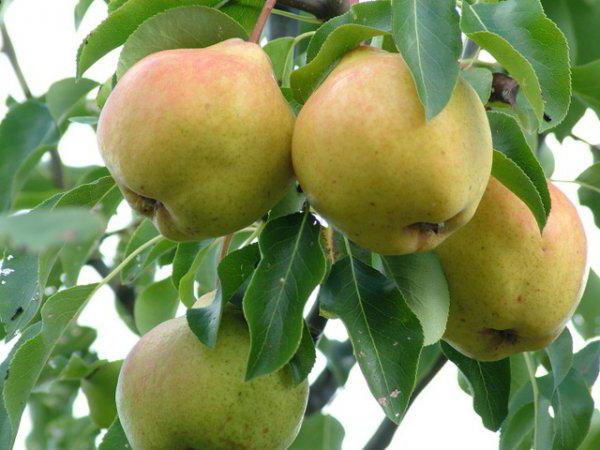
Description
Reviews of those gardeners who chose this particular variety for planting indicate that they do not regret it at all. He was bred at the Timiryazev Agricultural Academy. Pear "Muscovite", the description, photo of which is given below, ripens in the fall. It is zoned mainly in the Central region, in the Volga and Middle Volga districts. It is a medium-sized tree with a dense conical crown. The leaves of this variety are small, oval, with jagged edges. The flowers are white, they are bowl-shaped. The leaves of the variety have no edge, they are smooth and curved in the center. In carpal inflorescences, there are from five to seven flowers. Pear "Muscovite", the photo, reviews of which are presented in this article, has yellow-green fruits weighing up to one hundred and thirty grams. They have a juicy, dense pulp and a pleasant sweetish-sour taste. The fruits are stored for a long time, while they do not lose their presentation for a long time. At a temperature of about zero degrees, they can lie for up to a hundred days without loss of properties.
Distribution region, suitable climate
The Muscovite was bred and began to spread in the 80s of the last century. The variety was based on a seedling of American origin Kieffer. Free pollination brought it to obtain a hybrid that inherited excellent fruiting and resistance to external factors. The authors consider S. T. Chizhov and S. P. Potapov, scientists who carried out breeding work in the framework of the research of the Moscow Agricultural Timiryazev Academy.
The variety became widespread in the Central, Middle Volga, Volgo-Vyatka regions. In 2001, Moskvichka was included in the State Register for recommending pear cultivation in the Central Region of the Russian Federation. In the Moscow region, a tree can be seen in almost every garden. In the middle latitudes of the country, the variety needs insulation for the winter, since its resistance to frost is only slightly higher than average (it can withstand up to -20 ° C without shelter). It is experiencing temperature changes with dignity, avoiding crop losses.
Features of the variety
The Muscovite pear variety is distinguished by its high yield even in rather unfavorable conditions. From each tree, subject to all growing standards, you can collect up to fifty kilograms of delicious fruits. The "Muscovite" pear can begin to bear fruit as early as the fourth or fifth year after disembarkation. The variety is characterized by the fact that even the ripe fruits do not fall from the tree. However, for long-term storage, experts recommend harvesting before the first signs of ripeness appear.In this case, the fruits will ripen gradually, and therefore they will last longer in a closed room.


Breeding history and breeding region
The origin of the Moskvichka pear is from the seedlings of the Kieffer pear variety bred in Philadelphia. In experimental trials in 1986, carried out at the variety testing site in the cities of Moscow and Orel, the variety generally did not form fruit.
However, a year later, there was a global change in the study. In unfavorable weather with a low air temperature during flowering, high fruit set was noted. Revealed more than 50% of the control indicators. All this happened with artificial and natural self-pollination.


Green fruits of Moskvichka on a bush
Muscovite belongs to the pear variety, which is included in the State Register of the Russian Federation, as a selection variety for cultivation in the northern latitudes of our country.
Advantages and disadvantages
Advantages of the variety:
- early autumn variety;
- dessert type of variety;
- has early maturity;
- stable fruiting;
- high productivity;
- lack of fruit drop;
- has a high-quality presentation;
- excellent aromatic taste;
- excellent portability of transportation;
- long-term storage;
- resists fruit rot, brown spot, scab;
- resistant to aggressive environmental conditions.
Disadvantages:
- self-infertile variety;
- average degree of frost resistance;
- low drought resistance.
It enjoys mass popularity of commercial quality.
Planting tips
Pear "Muscovite", the description of which indicates that it is quite unpretentious, does not require careful maintenance. In order for this fruit tree to take root and begin to bear fruit abundantly, certain rules must be followed when planting. The Muscovite pear, the photo of which is presented in this article, is planted in the fall - early October, as well as in April or May. Experts recommend choosing a place for a tree near such pollinating varieties as "Lada", "Elegant Efimova", "Marble", etc. The site should be dry, even and, of course, well lit. Few people know that the taste of the fruit depends on the amount of light received by this fruit tree: the more, the better. Pear "Muscovite" does not tolerate stagnation of moisture in the ground. Therefore, you should make sure that the groundwater is at a depth of at least two and a half meters. Otherwise, the tree may even die.
Planting technology
Pear Moskvichka will consistently give a good harvest only if planting technology is observed.


Timing
Saplings are purchased in the fall, and planted in October or April-May. Trees planted in autumn usually do not have time to take root well and may die in winter. Therefore, it is better to dig the purchased seedlings in the garden or put them in a cold place until spring. In the spring, disembarkation is carried out before the start of the movement of juices. In this case, the soil should warm up, and the buds should swell.
Saplings Moskvichki with closed roots can be planted from April to October.
Site selection and pit preparation
It is advisable to place the pear on a small, well-lit and protected from cold winds hill. It is not allowed to plant a tree on swampy and excessively humid areas with underground waters lying close to the surface, otherwise the pear will die due to the drying out of the root system.
Chernozem soils with a pH of 4.2-6 are suitable for the Moskvichka pear. If the soils are sandy or sandy loam, it is necessary to dig a large hole with a volume of 1-1.5 cubic meters under the seedling, fill it with a fertile substrate.
See also
Description and varieties of Duchess pear varieties, planting and care
To read
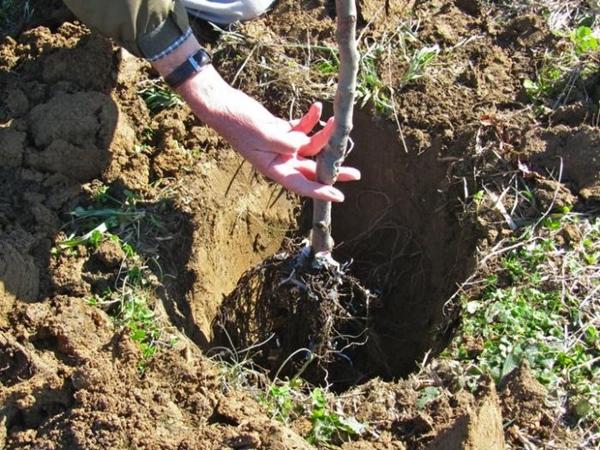

Distance between trees
To ensure good ventilation and illumination of the crowns, trees should be planted in increments of 4-5 m.
Schemes and rules for planting trees
If the plant is planned to be planted in the fall, a pit is prepared for it in 2-3 weeks.In the case of spring planting, a hole is dug in the fall. Its depth should be 70-80 cm, and its diameter should be 0.8-1 m. If the soil is heavy, a drainage layer of 10-15 cm is arranged at the bottom of the pit. If the soil contains a lot of sand, the bottom of the pit is covered with clay to retain moisture.
The same amount of black soil, peat, humus and sand, 300-400 g of superphosphate and 3-4 liters of wood ash are laid in the pit. From above, the pit is covered with a film or roofing felt to prevent the loss of nutrients.
In the spring, the damaged and dried roots of the seedling are removed. It is placed in a solution of cow dung or root growth stimulant for 24 hours.
A recess is dug in the center of the planting pit. A support 1 m high is placed 10-12 cm from the center. A slide is formed in the recess and a seedling is placed on it. In this case, the root collar should be located at the top of the slide, and the roots should be straightened along its sides. The deepening is covered by tamping the soil.
Around the pit, a trunk circle is made of earth, covered with a roller. The trunk of the tree is tied to a support. The soil is watered abundantly. The root collar after subsidence of the earth should be located flush with the ground surface.
After absorbing water, the soil is loosened, mulched with hay, humus, straw or rotted sawdust. The central conductor is cut to a level of 0.6-0.8 m, and the branches are halved.
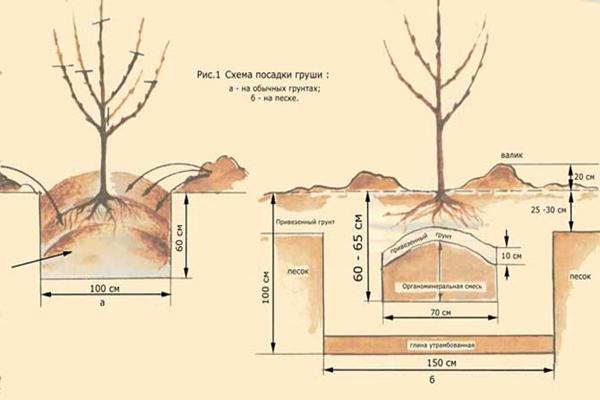

The soil
The pear variety "Muscovite", judging by the reviews, grows well on loamy and sandy loam-chernozem lands, the acidity level in which is approximately 5.6-6.0. It is very important to know that you cannot plant this culture in clay soil, and if there is no other way out, then you should definitely make a planting hole from a more suitable soil composition.
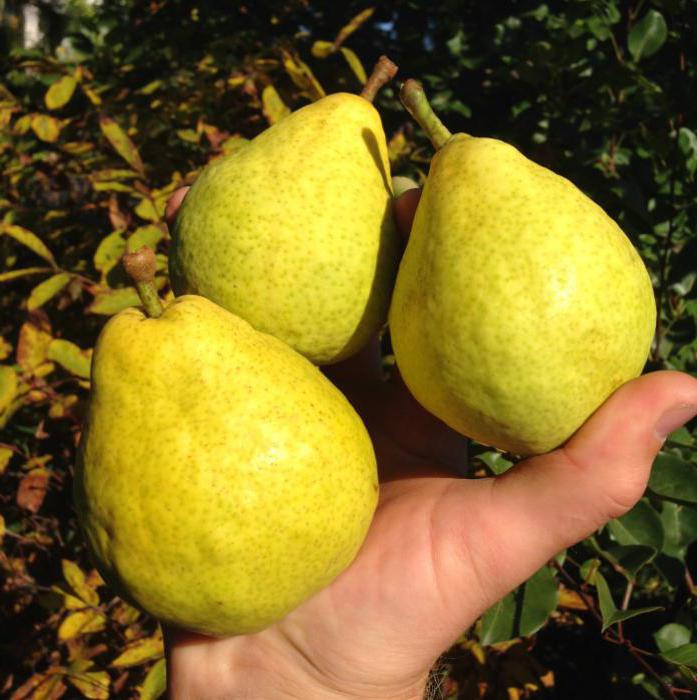

What kind of pear does it belong to?
Pear "Moskvichka" is dessert variety with autumn ripening of fruits... Thanks to early maturity, excellent presentation, good keeping quality and other qualities, it is very popular with gardeners.
The purpose of the Moskvichka fruit is universal. They are delicious fresh and good for making compotes, preserves, jams, marmalade, candied fruits and dried fruits.
Dessertnaya Rossoshanskaya, Krasulya, Gera, Vernaya and Lesnaya Krasavitsa are also distinguished by their versatility.
Site preparation
In order for the Muscovite pear to take root and normally adapt to the surrounding conditions, the following features should be taken into account. The planting hole must be prepared at least two weeks before the seedling is directly placed in the ground. Many gardeners who have had this pear variety for a long time say that if a crop is to be planted in the spring, then the place should be prepared in the fall. In this case, the depth of the fossa should be from one hundred to one hundred and twenty centimeters with a diameter of one meter. The selected place must be filled with fertile soil. You will need to prepare it in a certain way. To do this, the upper sod layer of soil is mixed with three buckets of humus, two parts of sand, three large (tablespoons) tablespoons of potassium, a glass of superphosphate, one kilogram of organic matter. Then a prepared pit is filled with the prepared composition and filled with a solution of dolomite flour in the amount of ten liters. After that, two buckets of clean water are poured into the same place. In this form, the hole is left for at least fourteen days, or, even better, until spring.
Care
The Muscovite is extremely unpretentious. It does not require either abundant watering or excessive preparation for the winter season. At the same time, proper care will help the tree to bring a bountiful harvest.
Pruning
The Muscovite has a pronounced stem and does not need strong crown-forming pruning. The tree requires sanitization in the fall, at the end of September, at which all dry, diseased and damaged branches are removed.In the spring, pruning consists only in discharging, that is, removing branches leading to thickening of the crown. It should be done in April before bud break. All operations must be done with a sharp, sterile instrument, without leaving hemp on the tree and cutting off the branches into a “ring” (near the base). Wounds should be immediately treated with garden varnish or covered with 2-3 coats of oil paint.
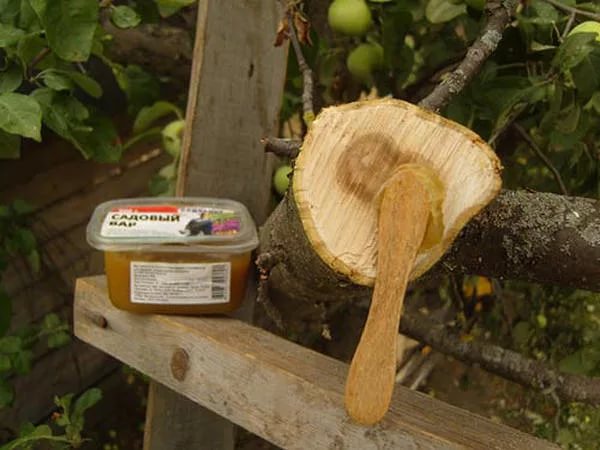

Wood cuts must be treated with garden varnish or paint
Watering
The pear does not like both drought and excessive watering. Whenever you wet the soil, consider the current weather conditions and the specifics of your site. A young tree of the first year of growth requires regular watering every 7-10 days with 10-15 liters of water. For seedlings 2-3 years old, the frequency can be maintained up to 1 time in 2-3 weeks, and the volume of water can be increased to 20 liters at a time. A mature pear tree needs about 4–6 waterings per year.
It is especially worth moistening the ground before flowering and after the flowers have fallen - this affects the yield of the pear. The water norm for an adult tree is 35–50 liters. This volume can be divided into two parts: morning and evening. Also, do not skip the autumn moisture-charging watering in October, since a lack of moisture can dry out the bark of a tree, which will negatively affect its frost resistance. The consumption rate is about 60 liters for each 1 m2.


It is optimal to water the pear using the sprinkling method
It is best to water a pear by sprinkling, spraying water with a special device along the projection of the crown. But the usual methods are also suitable. To do this, dig 2–3 irrigation furrows 5–7 cm deep around the tree. The first irrigation furrow should be 50–60 cm from the trunk, and the next should have a step of 35–40 cm. Water should be poured into them, and then loosened tree circle and mulch the ground under the tree.
Fertilizer
Fertilizers from the planting pit will feed the young tree for another 2-3 years. In the 4th year of growth, you need to start additional feeding of the plant. At the same time, mineral fertilizers are applied to the soil every year: 30–40 g of nitrate, 70–100 g of potassium salt and 300–500 g of superphosphate (in the spring before flowering or 2 times before and after flowering). Fertilizers are dissolved in water or sprinkled into the trunk circle. The latter method requires cloudy rainy weather. You must first dig up the ground under the tree.
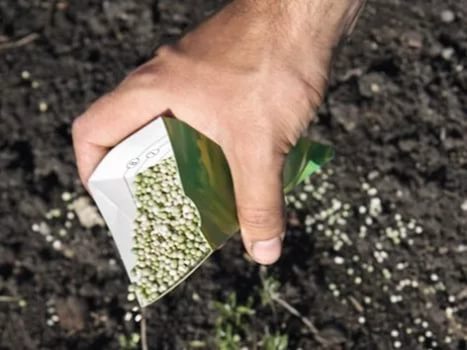

An adult pear tree needs mineral fertilizing
The tree needs organic feeding once every 3 years. It is usually carried out in the fall when digging. Under an adult tree, you need to make 30-40 kg of compost or humus. You can replace them with a solution of chicken manure. To do this, use 1 kg of manure and 3 liters of water. The mixture is allowed to brew for 3-5 days and introduced into furrows 5-7 cm deep from two or four sides along the edge of the trunk circle.
Wintering
Pear Moskvichka tolerates frost well, but extra preparation will help the tree to revive more easily in spring, and will also get rid of pests. Preparation of pears for winter is carried out as follows:
- It is necessary to dig up the trunk circle, having previously cleared it of branches, weeds and fallen leaves.
- Clean the trunk of the pear with a metal brush to increase its frost resistance and remove possible pests.
- It is good to mulch the soil near the tree with sawdust or peat, laying a layer of 15–20 cm.
- Whitewash the trunk of the tree and 1/3 of the skeletal branches of the pear with a solution of lime, taking 2 kg of lime, 1 kg of powdered clay and 300 g of copper sulfate. For young trees, this mixture is diluted with 15-18 liters of water, and for adults, 10 liters are used.
- Insulate the trunk with spruce branches or burlap.
- At the first frost, you can freeze the ice under the tree by spilling the earth from a hose with water.


Whitewashing protects the tree from frost and pests
Seedling preparation and planting scheme
Pear "Muscovite", a description of the care of which can be read in this article, involves preliminary processing of planting material.Before placing in the ground, the roots of the seedlings should be soaked in plain water for a day. Then you need to carefully cut off all diseased and defective branches. After that, in the central part of the pit, a peg should be driven in at a depth of fifty centimeters, a mound of earth should be poured near it and a pear seedling should be installed in it. Then you need to carefully evenly straighten all the roots. After that, the pit with the seedling is covered with earth without fertilization. It is necessary to ensure that the root collar of the tree remains five to seven centimeters above the ground. Then you need to carefully tamp the earth and pour two or three buckets of water into the hole. The soil around the seedling must be covered with humus. At the very end, you need to tie a tree to a peg. After planting, you should constantly monitor that the ground around the seedling practically does not dry out. Do not forget about loosening the soil, carrying out this process at a depth of up to fifteen centimeters. Another step in caring for a pear of this variety is the timely removal of weeds around the tree. This helps to avoid diseases or pests.
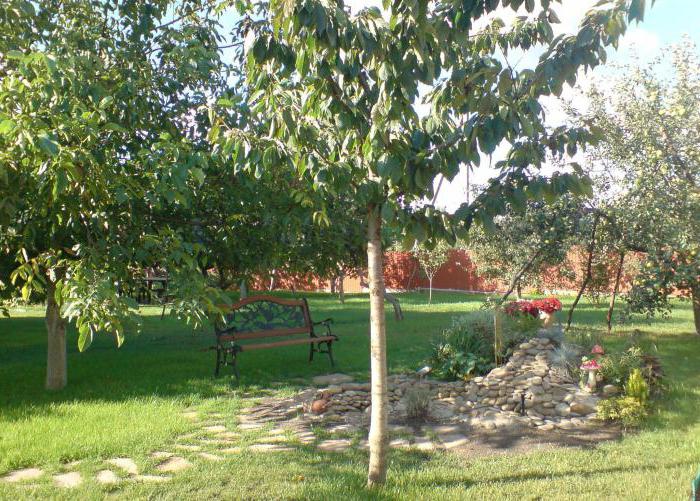

Diseases and pests
The resistance of the variety manifests itself against brown leaf blight, fruit rot and scab.
In the spring, prevention of spraying against fungal diseases is carried out:
- urea solution - 700 g - 1 bucket of water;
- solution of copper or iron sulfate - 150 g - 1 bucket of water.
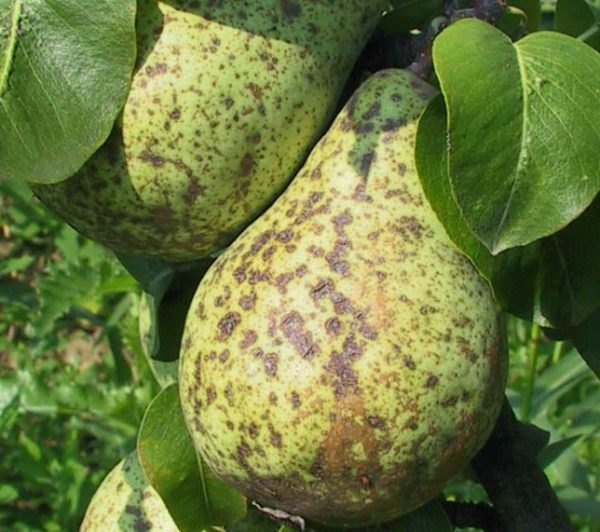

Scabbed Pear Fruit
Prevention of pear pests is carried out as follows:
- from green aphids, pear podzhorka, pear honeydew:
in the middle of spring - the drug "Kinmix",
before flowering - "Agravertin",
with ovary - "Iskra",
folk methods: decoction of chamomile, green soap;
- from a tick: a solution of colloidal sulfur;
- from leaf rollers: before flowering - "Cymbush".
In the spring, damaged and wounded trees must be healed. This helps to limit the spread of disease.
Proper watering
Pear "Muscovite" (the description of the variety is proof of this) - quite unpretentious to care for. However, its cultivation still requires knowledge of certain nuances. Many gardeners are interested in the question of how to properly water this fruit tree so that it bears fruit as well as possible. Experts believe that there is nothing complicated. Young trees should be watered once a week in the morning or evening. One seedling consumes about ten liters of water. Soil moisture should be about fifty to sixty centimeters deep. When the Muscovite pear begins to bear fruit, its irrigation regime from the beginning of July to the end of August should be correlated with the weather. And already in September, the introduction of water into the soil completely stops.
Yield
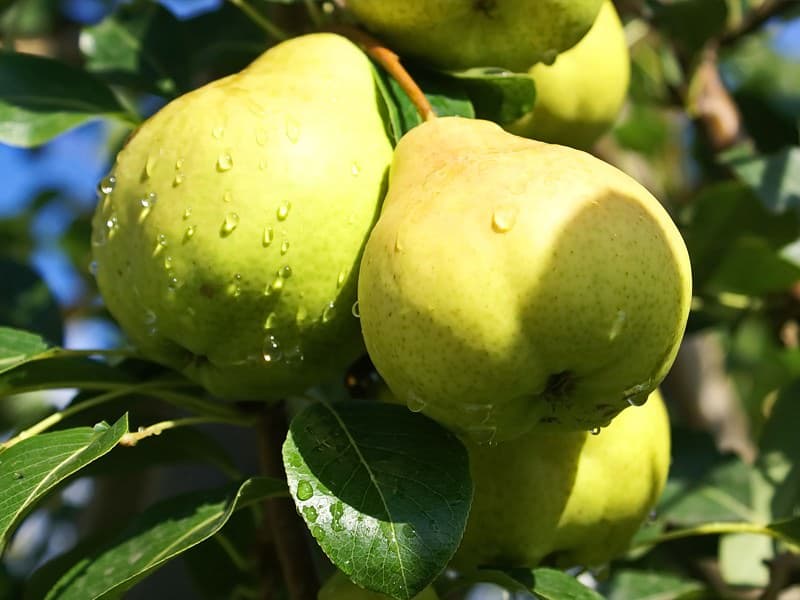

The description of the variety includes stable fruiting, which is not influenced by various factors, and this is one of the many advantages in characterization. In the first season, the seedling is not allowed to bloom, breaking off the inflorescences.
Such a procedure increases immunity and helps the plant to throw all the forces in order to successfully take root in a new place. In the second year, you can leave 10% of the ovaries. Muscovite begins fruiting in the third, fourth year. The ovaries are most often well preserved in large quantities.
The average yield is 35–37 kg per tree. With optimal weather conditions and good maintenance, up to 50 kg can be harvested. Fruits are harvested most often in mid-September; at cool temperatures, they are harvested at the end of the month. The technical conditions for the ripeness of the fruit are characterized by a color that has become lighter, yellowness should not appear yet.
It should be noted that Moskvichka is resistant to fruit shedding. Pears are notable for their beautiful presentation and tolerate transportation well until they are ripe.
You can store fruits both at home and in the basement specially designed for this, and just in the refrigerator.Indoors at room temperature there is a gradual ripening, pears acquire a sweet taste, the pulp becomes more juicy.
You can keep them like this for 10-15 days. In a fruit storage or refrigerator with a mode of 0 ° C, the fruits will be well preserved for 3 months. Pears will stay in a cool basement for 3-4 weeks without sacrificing quality. They need to be folded into wooden or cardboard boxes, it is better to pluck with a stalk, trying not to damage the integrity of the skin.
Dessert variety Moskvichka is used both for fresh food and for jam, preparation of compotes, jams, canned food for long-term storage. Fruit jelly, candied fruits, fruits in syrup - the variety of possible blanks from pears of this variety allows you to use any fruits, especially those that have not grown to a standard size. Dried Slices - Dried fruits are stored for a year without losing nutritional value.
Top dressing
You can fertilize this pear variety from the next year after planting a seedling. In the spring, the tree is fed with ammonium nitrate at the rate of twenty grams per square meter. Do not forget to apply organic fertilizers every three years. We are talking about superphosphate at the rate of fifty grams per square meter, compost - half a bucket for each tree, potassium sulfate - 20 grams per square meter. m. Agricultural technicians say that it is best to fertilize the "Muscovite" pear in the fall, then the tree will better absorb nutrients.
Features and growing conditions
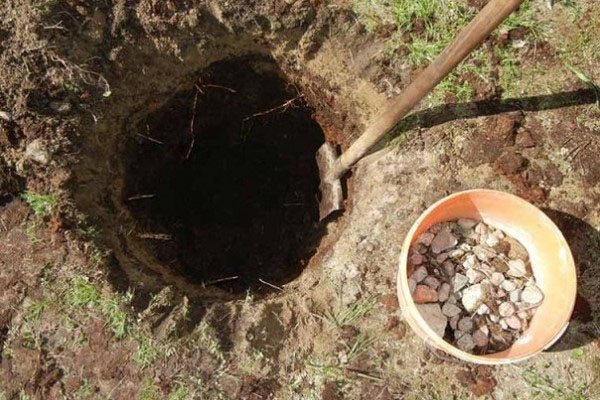

Planting pears of the Moskvichka variety should be carried out in open, well-lit places. It does not impose special requirements on soils, but it develops and bears fruit best of all on fertile soils with a slightly acidic or neutral reaction.
The place for planting a pear seedling must have good drainage. Stagnant moisture is very harmful to pear trees.
When laying a planting pit, 3-4 buckets of well-rotted manure, 1-1.5 superphosphate, about 600 g of calcium chloride and 2.5-3 kg of lime are necessarily introduced into it. In the first year after planting, in the absence of rain, the seedlings must be watered. For one tree, approximately 2-3 buckets of water are required.
Caring for the Moskvichka pear in the subsequent years of cultivation consists in the spring and autumn application of organic fertilizers once every 2 years. For these purposes, you can use humus or peat at the rate of half a bucket per square meter. For autumn application, fertilizers of the phosphorus-potassium group are used.
Of the features of growing Moskvichka, it is also worth noting its self-fertility. Therefore, pollinators must be planted next to it. The pollinator varieties for the Moskvichka pear are as follows:
- I love Yakovlev;
- Bergamot Moscow;
- Lada;
- Elegant Efimova.
Pruning rules
The Muscovite pear, like the vast majority of fruit crops, requires seasonal crown processing. Pruning should be started as early as two years of age. The main task during this procedure is thinning, as well as careful shortening of the branches. It is best to do longline pruning. In this case, you need to remove the branches so that the skeletal ones remain in the form of degrees at a distance of forty to fifty centimeters. Pruning is necessary for the pear both for maximum lightening of its crown, and for correct formation.
The procedure should be carried out either in early spring or late autumn. This will help to create the strongest possible skeleton of the fruit tree in order to withstand the considerable "load" of the future harvest. Up to four branches should remain on each tier. At the very beginning, you need to cut off those shoots that come directly from the trunk. Then branches growing parallel to it in a vertical direction are removed. Hemp should not be left behind, but you should not grab excess tissue either. Deep damage on the pear tree will take a very long time to heal.


After planting seedlings, their branches should also be cut off by almost a third of the length. Experts say that this is necessary for faster crown formation. Young pears are shortened to fifty to sixty centimeters from ground level. This stimulates the growth of buds and new shoots. Biennial trees are cut to a quarter of the trunk length.
Pros and cons of the variety
Like any variety, Moskvichka has its own advantages and disadvantages that distinguish it from competitors. Positive qualities include:
- early ripening of fruits;
- dessert taste;
- early maturity;
- regular fruiting;
- high yield rates;
- fruits are not prone to shedding;
- excellent product characteristics;
- pleasant strong aroma;
- the crop is suitable for long-distance transportation;
- the possibility of long-term storage of the harvested crop;
- increased resistance to common diseases;
- unpretentiousness.
See also
Description and characteristics of pear varieties Rogneda, cultivation featuresRead
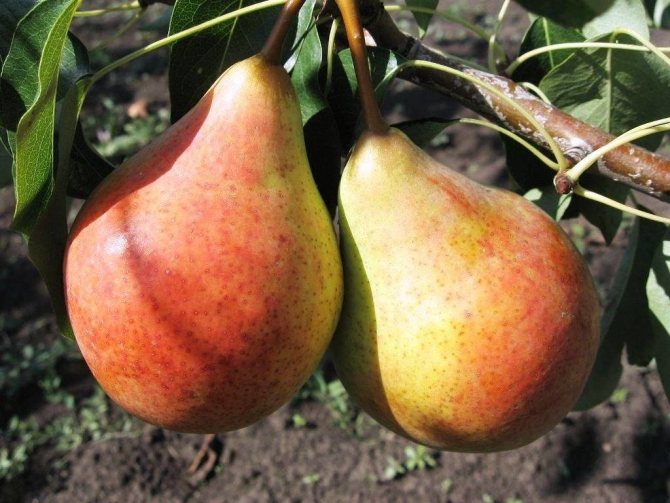

The disadvantages are:
- self-infertility;
- average frost resistance;
- low resistance to prolonged drought.
Harvesting
If the place was chosen correctly, and the planting process and the subsequent stages of care were carried out in compliance with all the requirements necessary for such a fruit tree as the Muscovite pear, gardeners' reviews indicate that the harvest will be quite good. Fruits are harvested, as a rule, from the first days of September to the end of the month. To make sure the pears are ripe, you should pay attention to the color of the skin: it must be yellowed. If so, then it's time to harvest.
It is best to collect the fruits before noon, because with an increase in the temperature level of the pear, gradually warming up, they are worse stored. When collecting, the fruit should be grasped with your fingers and taken to the side, and in such a way that the stalk remains on the plucked fruit. You should never shake pears from a tree, because they, if broken, will not be able to be stored for a long time.
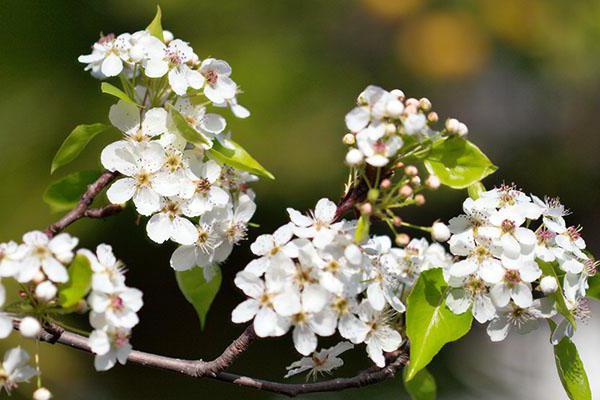

Selection of pear seedlings
Pear Abbot: variety description
To create a pear garden, planting seedlings can be carried out in spring and autumn:
- in the first version, they are planted in April - May, it is best to do this in the second half of April;
- in the second case in October, the recommended dates are 10 - 20 October.
Helpful advice. Planting in spring allows the trees to take root better, and it is easy to endure the winter cold. A pear planted in the fall will have excellent winter hardiness.
It is recommended to choose biennial or annual trees as seedlings, it is preferable to take a biennial plant that has a formed root system.
When buying a Moskvichka, you should pay attention to the following factors:
- seedlings should reach a height of 0.7 to 0.8 m;
- roots up to 20 cm long;
- there should be no broken branches.
Before planting, it is recommended to place the seedling in water or mullein solution.
Pear "Muscovite": photos, reviews
It can be said unambiguously that this variety is one of the most popular among Russian gardeners, and it is grown not only in the Moscow region, but also in many other regions. Many distinguish it, considering the Muscovite pear to be the most unpretentious and fruitful among the other varieties. The variety, judging by the reviews, is quite resistant to diseases and pests, and its fruits are stored for a long time. Plus they have excellent taste. With proper care of this pear, there is no doubt that it will certainly delight the owners with its delicious fruits, which are great both for harvesting for the winter and for use in various dishes and drinks.
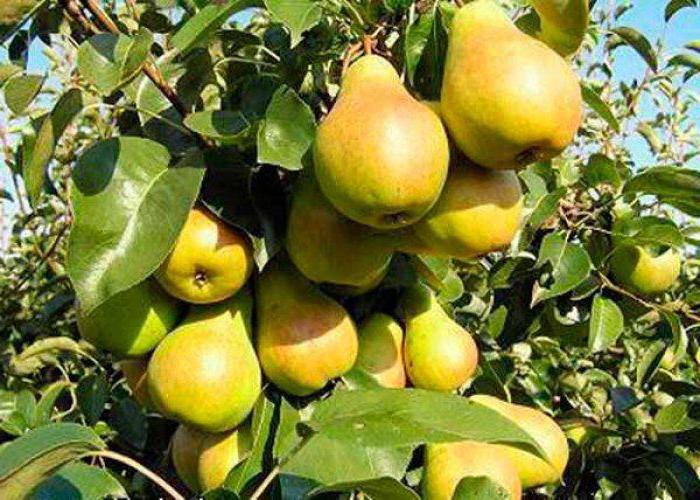

Many say that their trees, which are ten or even twenty years old, bear fruit every season. Judging by the reviews, the aroma of the fruit is carried around the house for a long time.Those who know firsthand about this variety of pears say that its only drawback is its strong sensitivity to overflow. For the rest, the tree is not afraid of anything: neither diseases, nor pests.
With proper care, many Russian gardeners collect up to forty kilograms of delicious fruits that can be stored for a long time. The main thing is to choose the right place for it on the personal plot and, if possible, plant a pollinator next to it. And then every year until December you can feast on these delicious fruits, which are perfectly stored in cardboard boxes until the first frost.
Gardeners reviews
Muscovite is a truly valuable variety for all gardeners. Hardy, with maximum fruiting, grown in many garden areas.
Kristina: They were rightly praised. Good winter hardiness. Dense juicy pulp. It has been growing beautifully in the garden for over 10 years. I treat the variety as "consumer goods". If you want to speed up fruiting, plant branches towards the horizon.
Ivan: From Moskvichka in full delight! One of the most valuable pears. Suitable for gardens of the Moscow region, grows very well. I do not use nitrogen fertilizers in any way. I get a gorgeous harvest!
Yana: The Muscovite bears fruit for the third year in the garden. She suffered least of all from cold and disease. The fruits are large and juicy.
The excellent characteristic properties of the Moskvichka variety deserve to become the most beloved one for everyone who loves pears. Proper care of the fruit tree will yield a bountiful harvest of delicious fruits in the future. A treasure of useful vitamins will always be on your table!

